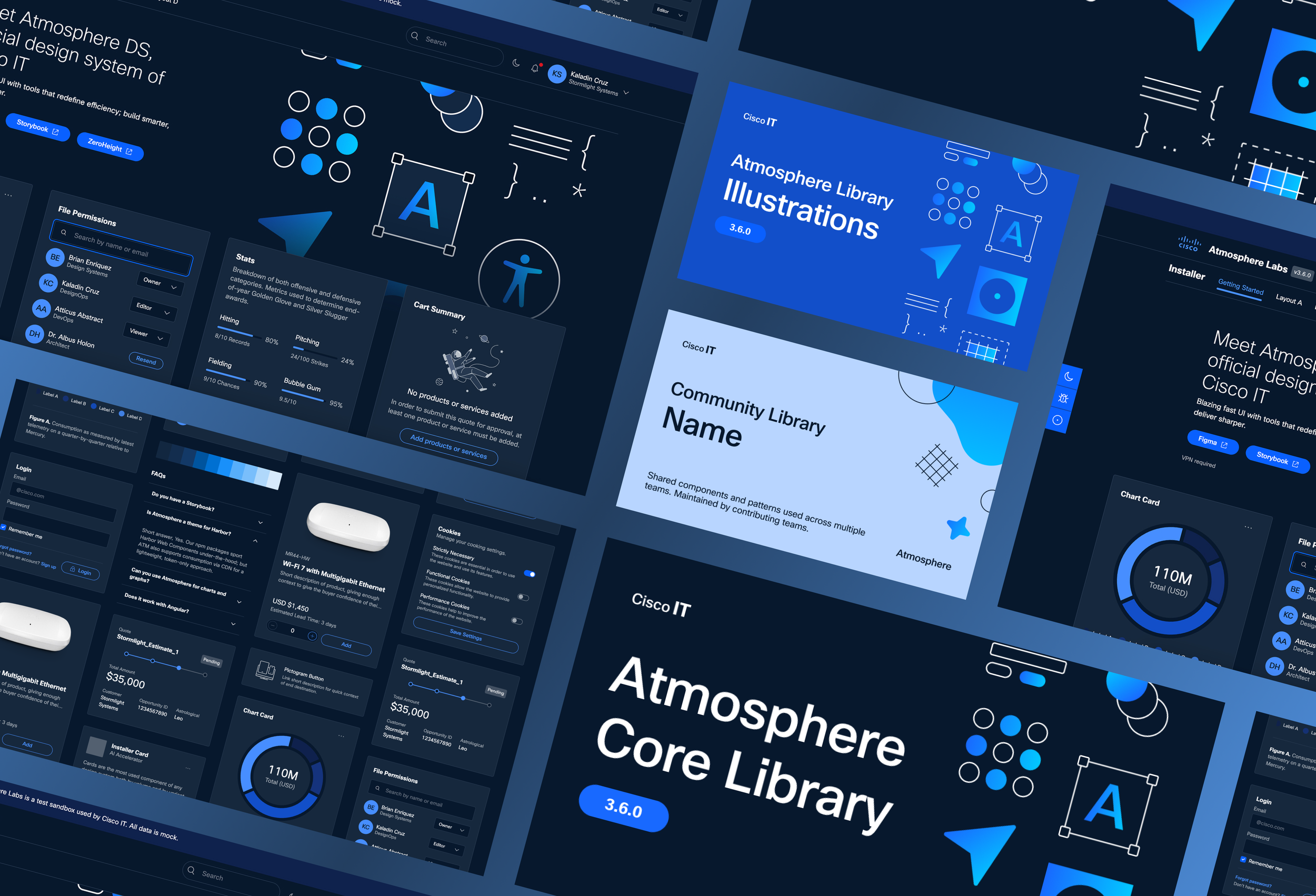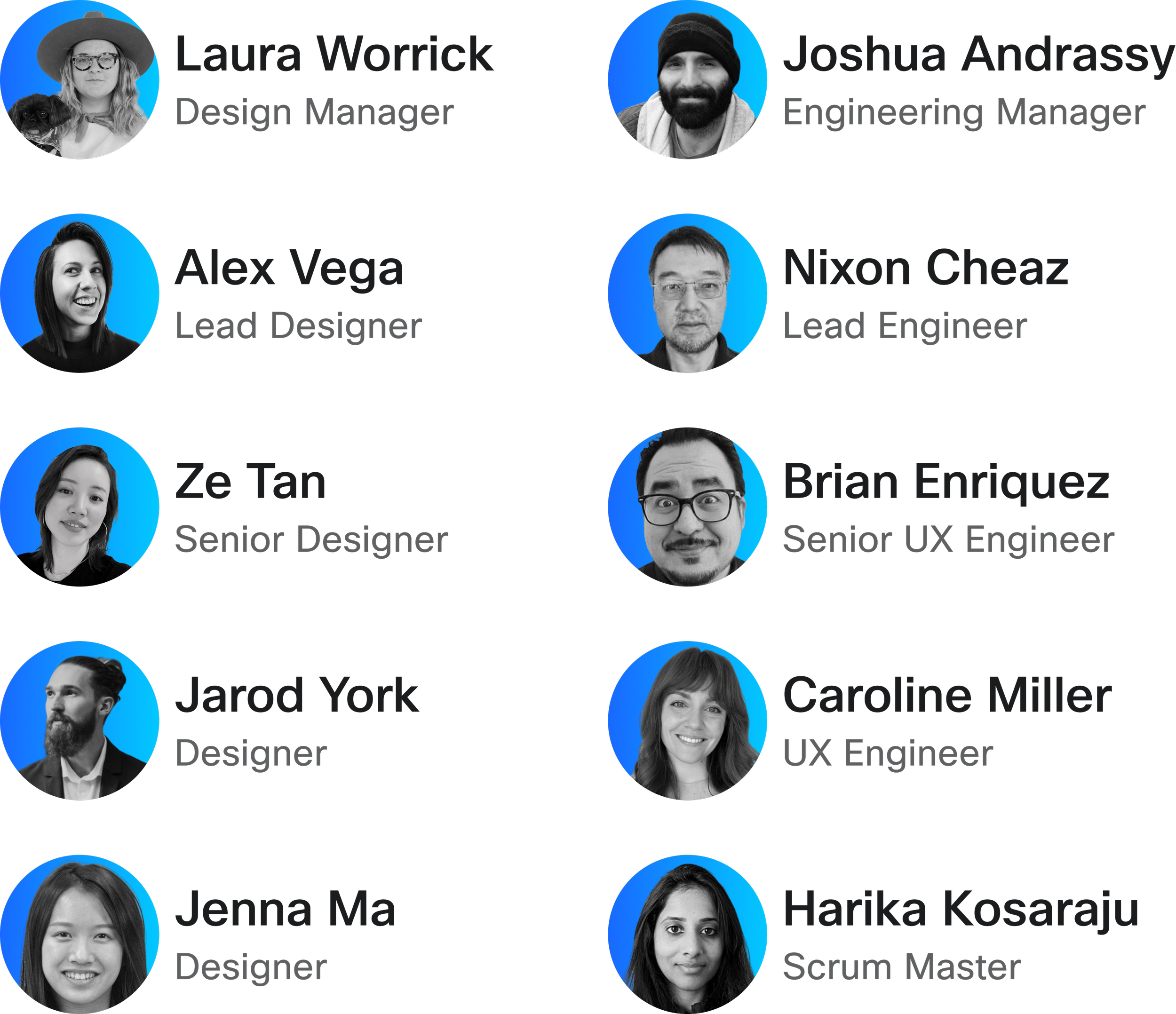Cisco
Atmosphere Design System

Build better, faster, and more consistently — together.
Pitch Deck

My Role:
Design manager and Product Owner
Leading the strategic vision, development, and adoption of Atmosphere across Cisco IT.
Core Team:
1 Engineering manager, 3 UX engineers, 5 product designers, 1 scrum master
Directly managed and mentored this core team to drive technical and design excellence.
Support team:
1 content designer, 2 visual designers, 2 UX researchers
Orchestrated cross-functional collaboration with broader team to ensure comprehensive system development.
Timeline:
2022 - present
Current Stats (August 2025)
60 teams leveraging Atmosphere across Cisco IT
Achieved widespread adoption with 60 teams leveraging Atmosphere across Cisco IT, signifying a significant shift towards standardized design and development practices and reducing redundant work across the organization.
90,000+ employees interacting with Atmosphere
Impacted 90,000+ employees by providing a consistent and intuitive user experience across internal tools, leading to improved productivity and reduced task completion time.
500,000+ average monthly Figma inserts
Drove high utilization with 500,000+ average monthly Figma inserts, demonstrating accelerated design velocity and component reuse, which directly contributes to faster product development cycles.
3,000+ average monthly developer package downloads
Facilitated rapid engineering adoption with over 3,000 developer package downloads monthly, indicating strong developer engagement and the system's direct contribution to accelerating product build times and ensuring technical consistency.
50+ components and patterns aligned across design and development
Established a robust foundation with 50+ components and patterns fully aligned across design and development, drastically reducing design-dev handoff friction and ensuring visual and functional consistency.
2 themes available (light and dark) with high contrast in development
Enhanced user accessibility and brand flexibility with 2 themes (light and dark), with high-contrast options in development, addressing diverse user needs and corporate branding requirements.
70+ combined design and engineering releases
Maintained continuous improvement and responsiveness through 50+ iterative design and engineering releases, ensuring the system evolves with product needs and technological advancements.
Our Offering
Unified Design & Code System
Shared foundation for building Cisco IT’s employee experiences
Seamless workflow from Figma to production code
Speed & Consistency
Standardized UI components, tokens, and patterns
Accelerates product development and reduces rework
Accessibility by Default
Components and guidance built to meet accessibility standards
Enables all teams to deliver inclusive digital experiences
AI-Driven Productivity
AI-powered MCP Servers connect ZeroHeight docs, Storybook, and Figma Dev Mode
Context-aware AI agent integrates with GitHub Copilot for accurate, real-time code generation from designs
Collaboration at the Core
Designed for designers and engineers to work together, not in silos
Processes, tools, and rituals to ensure true cross-functional teamwork
Comprehensive Documentation & Support
Up-to-date resources, guides, and best practices on ZeroHeight and Storybook
Office hours, internal forums, and responsive support channels
Continuous Improvement
Regular updates, feedback loops, and metrics-driven enhancements
Evolving to meet Cisco IT’s changing needs
Inspiration & Education
Atmosphere Labs: real-world examples and creative use cases
Onboarding, trainings, and hands-on demos for all users
But How Did We Get Here?
Background
Cisco employee experiences and products lacked alignment across functionality and visual design. Through research, we learned teams were using a variety of design systems Cisco offers, while others were doing their own thing entirely. This was creating a lot of friction for end users and product teams. End users, despite interacting with a suite of internal Cisco products, were faced with entirely unique experiences across the ecosystem, none of which visually reflected the Cisco brand. This resulted in employees spending additional time completing administrative tasks that added time and frustration to their core job responsibilities. For product teams, this meant spending unnecessary time recreating elements and components and lacking a single source of truth.
Our Challenge
How might we align employee experiences in a way that improves the user experience, speeds up delivery time for product teams, and is consistent with the Cisco brand?
Our Approach
IKEA Analogy
Creating Stakeholder and Product Team Buy-in
To ensure broad organizational understanding and secure buy-in, we developed a clear, relatable analogy (e.g., 'the design system as IKEA') and graphic to demystify its function.
Our Structure
We implemented a federated model where Atmosphere core libraries amplify the Cisco Brand and the expression of the Cisco IT Design Language. This strategic choice allowed for centralized governance of foundational elements while empowering local product teams to create contextualized libraries, balancing consistency with product-specific needs and accelerating localized development.
Our Tools
We strategically selected a robust toolchain including Figma, GitHub, Storybook, ZeroHeight, Jira, PowerBI and a custom “labs” environment. These tools were chosen for their scalability, integration capabilities, and ability to support seamless collaboration across design, development, and documentation, as well as for enabling data-driven insights and decision-making. This optimized our workflow and ensured a single source of truth for both assets and performance.
Our Journey
Challenges and Opportunities
As a cross functional design systems team, we have had the opportunity to bring to life so many important assets and artifacts for product teams to leverage. Although we started small, our team has continued to grow; and with that comes evolving needs and demands. We’ve encountered challenges that have forced us to reevaluate, iterate, learn and try new things. The three primary opportunities we identified were:
Missing Processes:
Challenge: Expectations for how to use Jira and how to communicate with one another wasn't aligned, leading to project delays and miscommunication.
Opportunity: With the input and collaboration of the team, I implemented agile rituals and developed standards, workflows and expectations to create alignment and develop team culture:
Twice-weekly standups and parking lot sessions: Real-time cross-discipline sync, feedback, and support
Thursday Working Sessions: Live design/dev co-working and problem-solving
Shared Jira board: Unified workflow for designers and engineers; cross-functional epics with co-owners
Inclusive language: No “handoffs”; always “working together”
Governance and ownership: Each epic has a designer and developer co-lead
Open feedback loops: End of sprint retrospectives and team-building activities
Shifting Priorities - Opportunities to build a stronger roadmap and prioritization process to prevent shifting priorities and “swoop and poop".
Misaligned Resources - Our design and development libraries were out of sync, which meant developers didn’t have access to a 1:1 library of the designers’ resources.
Read or watch more about our journey “From Forming to Performing”.
Northstar Workshop
I had a saved a The Framework
•2 hours session
•What is the current state of Atmosphere now?
•What do we want Atmosphere to be when it grows up? What does good look like?
•Identify the core needs and understand their interdependencies.
Outcomes
V3 release alignment
Our Success
things we’ve launched
before and afters of products (directory)







